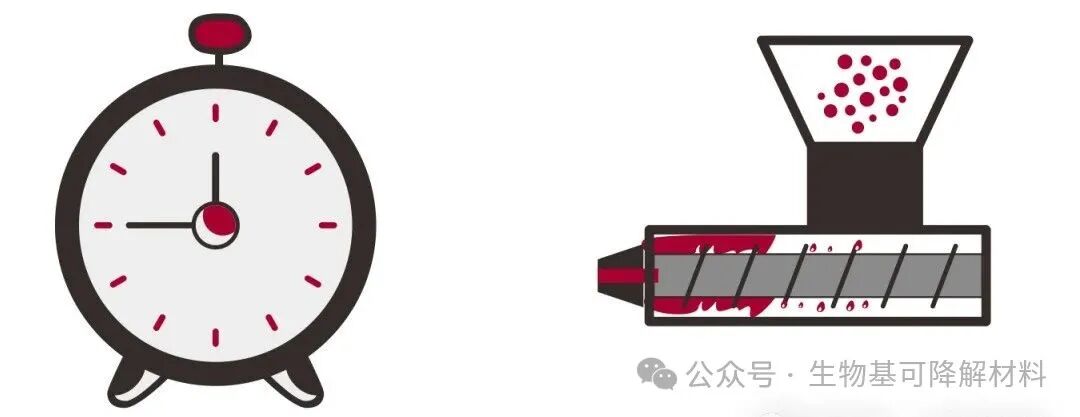Calculation and Application of Residence Time of Polymer Materials in Screw Extruders
In polymer material processing, especially in the extrusion molding of degradable materials, the residence time of the material in the screw extruder is a critical parameter.Also known as residence time(HUT) refers to the time plastic pellets take from entering the extruder to flowing out of the die, which is directly related to whether the material will undergo thermal degradation due to prolonged heating. Today, we will discuss how to scientifically calculate this time and its importance.

Calculation formula of residence time
In actual production, the commonly used residence time (T) calculation formula is based on the volumetric flow rate of the material and the filled volume of the material inside the extruder, as follows:
T =V/Q
Among them:
T represents the dwell time (unit: minutes).
V is the effective filling volume of the material inside the extruder (unit: liters), which can typically be estimated based on the screw diameter, effective length, and filling rate (for simplified calculations, it can be approximated as the effective volume of the screw, i.e., V = Πd).2L/4000, where d is the screw diameter (cm) and L is the effective length of the screw (cm).
It should be noted that:
In the formula, use "V = Πd".2L/4000" calculates the total volume of the barrel (i.e., the volume of the cylindrical space inside the barrel). However, in reality, the screw itself occupies a portion of the space inside the barrel, and the material can only fill the threads between the screw and the barrel. Therefore, this formula is essentially a simplified estimation for the following reason:
For example:
Taking the extrusion processing of PBAT material as an example:
If the filling rate is 60%, the effective filling volume of the material V = 8.7 * 60% ≈ 5.2 liters.
Under this process, the actual residence time of the material is approximately 1.3 minutes, which is much lower than the thermal degradation critical time of PBAT (usually 5-8 minutes), ensuring process safety.
The role of scientifically managing dwell time.
Avoid thermal degradation: For polymers such as bio-based biodegradable materials that are sensitive to heat, prolonged residence time can lead to chain scission and performance degradation. Scientific management can effectively reduce these issues.
Ensuring product stability: Stable residence time ensures uniform heating and shearing of materials, reducing fluctuations in product performance (such as mechanical properties, appearance, etc.).
Improve production efficiency: By optimizing residence time, it is possible to reasonably increase processing speed without causing degradation, balancing quality and capacity.
Reducing production costs: minimize waste caused by degradation, reduce rework rate, and indirectly enhance production efficiency.
By mastering the calculation method of residence time, practitioners can more accurately adjust parameters such as screw speed and feed rate, providing a scientific basis for the extrusion processing of polymer materials. This is especially crucial for ensuring product quality in the case of heat-sensitive bio-based degradable materials.
【Copyright and Disclaimer】The above information is collected and organized by PlastMatch. The copyright belongs to the original author. This article is reprinted for the purpose of providing more information, and it does not imply that PlastMatch endorses the views expressed in the article or guarantees its accuracy. If there are any errors in the source attribution or if your legitimate rights have been infringed, please contact us, and we will promptly correct or remove the content. If other media, websites, or individuals use the aforementioned content, they must clearly indicate the original source and origin of the work and assume legal responsibility on their own.
Most Popular
-

List Released! Mexico Announces 50% Tariff On 1,371 China Product Categories
-

Nissan Cuts Production of New Leaf EV in Half Due to Battery Shortage
-

New Breakthrough in Domestic Adiponitrile! Observing the Rise of China's Nylon Industry Chain from Tianchen Qixiang's Production
-

Dow, Wanhua, Huntsman Intensively Raise Prices! Who Controls the Global MDI Prices?
-

Mexico officially imposes tariffs on 1,400 chinese products, with rates up to 50%






